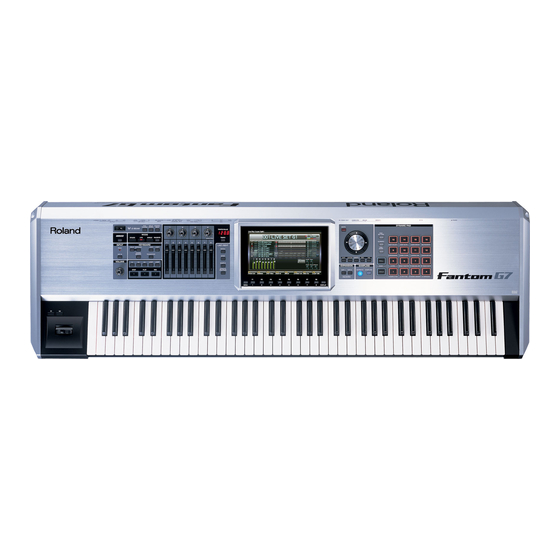Advertisement
Quick Links
Advertisement

Summary of Contents for Roland Fantom-G Series
- Page 1 Workshop ®ÂØÒňΠ® Fantom-G Workstation Keyboard Manipulating Sounds in Realtime © 2009, 2010 Roland Corporation U.S. All rights reserved. No part of this publication may be reproduced in any form without the written permission of Roland Corporation U.S. FGWS09...
-
Page 2: About This Booklet
Clicking or Pressing As explained in the Power User Control Fantom-G Workshop booklet, you Roland’s Fantom G6, G7, and G8—the Fantom-G family—set a new standard can perform most operations on the Fantom-G using either a connected for excellence in workstation keyboards, with spectacular sounds and mouse—sold separately—or the Fantom-G’s own front-panel controls. - Page 3 What Is Realtime Control? The Fantom-G Realtime Controllers Here’s an introduction to the Fantom-G’s realtime controllers. We’ll explain When we use the term “realtime control, ” we’re referring to instantaneous how to set them up a bit later. changes you make to a patches and their PFX as you play. “Realtime controllers”...
-
Page 4: Foot Controls
You can gain foot control of various things in the Fantom-G by connecting Modulation Lever, are suited to switching things on an expression pedal such as Roland’s EV-5 or EV-7, a damper pedal like the and/or off. Roland DP-10, DP-8, or DP-2, or a footswitch such as the FS-5U or FS-5L. - Page 5 manipulate the values of up to four of the patch’s parameters. Realtime controllers in Live mode affect any patch whose Keyboard Let’s set up Control 1 for this patch to show how this works. switch is turned on. Use F2 (Group/Down) to select the Control 1 parameter group. Setting Up Something to Control To get a patch or its PFX to respond to realtime control the way you want, you’ve got to program it to respond to the Control Change messages you’ll...
- Page 6 Since we’re concerned with setting up the use of a realtime controller The patch is now set up for realtime control. If you like, you here, select a Control Change message—we’ll select CC74 (Cutoff ) for can jump ahead to setting up the realtime controls, where our example.
- Page 7 Select the first control source using the 1 Control parameter. You can The Control Setting Screen select Most of the remaining realtime controllers are configured on the Control • OFF— to turn off the control. Setting screen. (The foot pedals are set up on the System screen.) To get •...
- Page 8 Who Controls the Controllers? Setting Up the Control Knobs Since every live set and studio set has its own D Beam, control knob, control slider, and S1 and S2 switch settings, each live set or studio reconfigures these controllers as it’s selected. There may be times, however, when you’d prefer that the controllers behavior stays put as you select new live sets or studio sets.
- Page 9 Setting Up the Control Sliders Setting Up the S1 and S2 Switches Set each control slider’s Slider Assign parameter to: You can choose both the type of message generated when you press the S1 or S2 button, and also each button’s behavior. •...
- Page 10 Other S1 and S2 Switch Uses Setting Up the D Beam • AFTERTOUCH— so that pressing an S button generates a value of 127 or This parameter selects the job you’d like the D Beam to perform. It can be 0 in all three modes, according to the Assign Mode setting.
- Page 11 The Assignable mode D Beam parameters are: Using the D Beam as a Solo Synth • Type— This parameter selects the type of data the D Beam produces. When it’s set to • OFF— the D Beam doesn’t do anything. •...
- Page 12 Setting Up a FOOT PEDAL CTR Jack Pedal or Switch press the back of the pedal, you can make it behave like a Roland pedal by setting Polarity to REVERSE. Second, there may be times when Here’s how to set up a foot pedal or footswitch connected to the FOOT...
-
Page 13: System Control
Fantom-G. When Assign is set to using a Roland pedal, and REVERSE to get a non-Roland pedal to PANEL SWITCH, the Panel Switch Assign parameter becomes active and behave like one. can be set to: The Continuous Hold Pedal parameter, when it’s set to ON, supports... - Page 14 If you change the control source assigned to the System Control, you therefore automatically change the control source of any sound set to use All of the factory patches are set by default to use System Controls 1-4 as their four control sources. As a result, it’s easy to change a control source for all of these patches at once by simply changing a System Control to whatever it is you want to use.







